|
|
|
Sort Order |
|
|
|
Items / Page
|
|
|
|
|
|
|
| Srl | Item |
| 1 |
ID:
122578
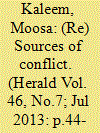

|
|
|
| 2 |
ID:
118050
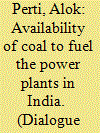

|
|
|
| 3 |
ID:
181972
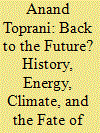

|
|
|
|
|
| Summary/Abstract |
The geopolitics of the twenty-first century will look very different from that of the twentieth century, but does that mean that the lessons of the latter do not apply to the former? Will competition for oil be eclipsed by that for rare earth metals or lithium, such that the form but not the substance will change? Or does the possibility of achieving self-sufficiency in energy consumption through renewables offer an alternative to interstate resource competition or interdependence? Most importantly, does the challenge of climate change compel Americans to rethink their rivalry with China? Reading The New Map will stimulate thinking along these lines, but doing so is only the first step.
|
|
|
|
|
|
|
|
|
|
|
|
|
|
|
|
| 4 |
ID:
116690
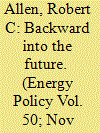

|
|
|
|
|
| Publication |
2012.
|
| Summary/Abstract |
This history of the transition from organic to mineral fuels suggests a number of conclusions that may have parallels in the future: People respond to price incentives; science is important but not sufficient; human capital is important; cooperation is as important as competition; path breaking technologies take a long time to mature.
The future, however, will not - and should not! - be a replay of the past. One of the greatest differences is the externality issues raised by global warming. The choice of fuels and technologies has ramifications far beyond the profit and loss statements of the people deciding them. In that case, decentralized decision making will not reach a desirable overall result. Planning and coordination are essential to tackle these problems.
|
|
|
|
|
|
|
|
|
|
|
|
|
|
|
|
| 5 |
ID:
166351
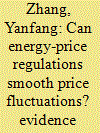

|
|
|
|
|
| Summary/Abstract |
Due to the dominance of coal in China’s energy mix, coal prices have always been a challenging part of pricing reform. The recent frequent government interventions raise the key research questions: what is the actual impact of price policies on coal price fluctuations, and how can forward-looking pricing policies be made. By proposing a novel classification of coal pricing policies and introducing an expectation and forward-looking coefficient, the paper examines the relationship between coal price fluctuations and pricing policies using the generalized method of moments (GMM) method. It shows that the lagging coal price and coal demand play a positive role in regulating coal prices, while coal supply and marketization have significantly negative effects on coal price fluctuations. The heterogeneous impacts of price policies are due to differences in market players’ expectations, policy instruments and the methods of policy release. In addition, China’s coal pricing policy portfolio from 2013 to 2016 exerted synergy effects on the restraint of coal price fluctuations. As the forward-looking coefficient was considerably low, the government's intervention behaviors were obviously biased towards ex post facto responses. The paper suggests short run and long run policies to advance marketization of coal prices amid the energy transition.
|
|
|
|
|
|
|
|
|
|
|
|
|
|
|
|
| 6 |
ID:
192178
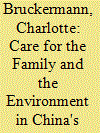

|
|
|
|
|
| Summary/Abstract |
In the “coal province” of Shanxi, residents grapple with tensions between caring for their families and caring about their environment. In creating ethical pathways through care, residents must navigate the paradox of livelihoods dependent on forms of development that endanger lives and pollute environments. This dilemma has crystallized over time, as the personal and particular demands of the present have become enmeshed with long-standing concerns over environmental degradation. Rather than characterizing family care as concrete and environmental care as abstract, acts of care in Shanxi link the reproductive crisis of the family with the reproductive crisis of the environment: the article presents instances under which the attention, empathy and recognition of care for concrete others are scaled up to the levels of ecology and planetary crisis.
|
|
|
|
|
|
|
|
|
|
|
|
|
|
|
|
| 7 |
ID:
155550
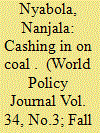

|
|
|
|
|
| Summary/Abstract |
Kenya’s plan to build a coal-burning power plant on the doorstep of an historic island has sparked some of the country’s most intense environmental organizing in years, reports journalist Nanjala Nyabola. Activists say the plan, part of Kenya’s foreign-policy pivot to China, would devastate marine life and the economy of one of the East African nation’s most important tourist destinations. In response to their legal appeals, a judge granted a stay on the project, but its future remains unclear.
|
|
|
|
|
|
|
|
|
|
|
|
|
|
|
|
| 8 |
ID:
149848
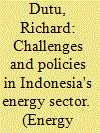

|
|
|
|
|
| Summary/Abstract |
Fossil fuels are central to Indonesia's energy policy, and its main source of export revenues. However, insufficient investment, the lack of transport infrastructure and an unwieldy regulatory environment are inhibiting the sector from reaching its full potential. Looking ahead, growing environmental concerns combined with sharp falls in coal prices and the on-going shale gas revolution call into question the sustainability of an energy strategy based almost exclusively on fossil fuels. This viewpoint challenges Indonesia's current energy policy and proposes ways to increase its energy efficiency and use of renewables. In particular, its gas sector should be further developed to plug the gap until sufficient renewable energy, especially geothermal, comes on line. Government control over the oil industry via state-owned Pertamina should be gradually reduced. Clarifying, streamlining and publicising simple regulations in energy, especially regarding land rights and on-shore processing, and removing foreign-ownership restrictions will help bring much needed investment. The pressure on the environment of natural resource exploitation should also be addressed by properly defining property rights and regulations regarding forest land, and implementing a positive implicit carbon price.
|
|
|
|
|
|
|
|
|
|
|
|
|
|
|
|
| 9 |
ID:
137673


|
|
|
|
|
| Summary/Abstract |
In 2013, China׳s national government abandoned its previous cautious policy and started to promote large-scale deployment of coal-based synthetic natural gas (SNG). Coal-based SNG is both carbon-intensive and very water-intensive. Driven by a smog crisis and the recession of coal industry, China׳s 2013 policy change is major setback in its long-term efforts in carbon mitigation and water conservation. The government of China made the policy change before the commercial commencement of China׳s first SNG demonstration plant. Since the commencement of China׳s SNG demonstration plant, many problems have started to appear. In this article, I discuss the nature of demonstration project and explain the danger in starting a crash program without evaluating the demonstration comprehensively and transparently.
|
|
|
|
|
|
|
|
|
|
|
|
|
|
|
|
| 10 |
ID:
116991


|
|
|
|
|
| Publication |
2012.
|
| Summary/Abstract |
Since China decontrolled coal prices, its coal price has risen steadily and been unusually volatile. In 2011 in particular, high coal prices and capped electricity prices in China discouraged coal-fired power generation, triggering widespread power shortages. We suggest that these coal-price disturbances could be symptomatic of a major change in pricing dynamics of global fossil-fuel markets, with increasing correspondence between coal and oil prices globally. Historically, global coal prices have been more stable and lower than oil and natural gas prices on a per-heat basis. In recent years, however, coal prices have been increasingly volatile worldwide and have tracked other fossil fuel prices more closely. Meanwhile, the recent development of unconventional gas has substantially decoupled US natural gas and oil prices. Technically, low US natural gas prices, with potential fuel switching, could drive US domestic coal prices lower. However, this effect is unlikely to counteract the overall trend in increasing coal consumption globally. China's market size and unique, partially-controlled energy system make its reform agenda a key force in the global economy. Policymakers in the US, E.U. and elsewhere should monitor China's economic reform agenda to anticipate and respond to changes accompanying China's increasing importance in the global energy economy.
|
|
|
|
|
|
|
|
|
|
|
|
|
|
|
|
| 11 |
ID:
114708
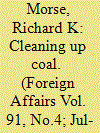

|
|
|
|
|
| Publication |
2012.
|
| Summary/Abstract |
Coal, the rock that fueled the industrial age, is once again remaking the global energy landscape. Over the past decade, while most of the world stood transfixed by the gyrations of the oil markets, the promise of alternative energy, and the boom in cheap natural gas, coal left all other forms of energy in its dust, contributing nearly as much total energy to the global economy as every other source combined.
|
|
|
|
|
|
|
|
|
|
|
|
|
|
|
|
| 12 |
ID:
149918
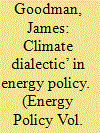

|
|
|
|
|
| Summary/Abstract |
Climate change expresses the global development crisis as a crisis for all societies. Governments in both over-developed and under-developed countries are forced to square the circle between climate crisis and energy policy. Across these contexts the policy imperative to reduce greenhouse gas emissions cascades into energy policy, and into wider fields of social and political life. The article investigates this process, advancing the concept of a ‘climate dialectic’ in policy change. From this perspective, the article develops a critique of climate policies as they have emerged in Germany and India. This positions Germany, a high-income post-industrial society, with India, a low-income industrialising country. Key climate and energy initiatives from each country are compared and discussed in terms of a common effort at expanded development opportunities. In this respect, with the key objective of maintaining ‘growth as usual’, the persistence of coal-fired power and coal extraction becomes highly politicised. Energy policies are found to be increasingly embedded in the wider ‘climate dialectic’, forcing new, more transformative possibilities onto the agenda.
|
|
|
|
|
|
|
|
|
|
|
|
|
|
|
|
| 13 |
ID:
035932


|
|
Coal
/ Court, W H B
|
1951

|
|
|
|
| Publication |
London, His majesty's stationery office, 1951.
|
| Description |
xii, 422p.Hbk
|
| Series |
History of the Second World War; United Kingdom Civil Series
|
|
|
|
|
|
|
|
|
|
|
|
Copies: C:1/I:0,R:0,Q:0
Circulation
| Accession# | Call# | Current Location | Status | Policy | Location |
| 008454 | 940.547794155324/COU 008454 | Main | On Shelf | General | |
|
|
|
|
| 14 |
ID:
162050
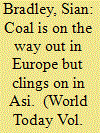

|
|
|
| 15 |
ID:
110756


|
|
|
|
|
| Publication |
2011.
|
| Summary/Abstract |
China has emerged as a leader in coal liquefaction. While the country's abundant coal resources and acute concerns about oil security help explain China's interest in liquefaction, the driving forces for this industry are complicated and policy has been inconsistent. Since 2006 Beijing has tried to slow down the development of liquefaction; even as China has become more dependent on imported oil, the central government has been wary about the large impact of liquefaction technologies on scarce resources such as water. However, local government officials in coal rich areas have strong incentives to pour investment into the technology, which helps explain the uneven development and policy. The future of coal liquefaction will depend on how these forces unfold along with major Beijing-led reforms in the Chinese coal industry, which is closing smaller mines and favoring the emergence of larger coal producing firms. Those reforms will have mixed effects on liquefaction. They temporarily contribute to higher prices for coal while over the longer term creating coal companies that have much greater financial and technical skills needed to deploy technologies such as coal liquefaction at a scale needed if this energy pathway is to be competitive with conventional sources of liquid fuel.
|
|
|
|
|
|
|
|
|
|
|
|
|
|
|
|
| 16 |
ID:
149917


|
|
|
| 17 |
ID:
162330
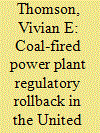

|
|
|
|
|
| Summary/Abstract |
President Trump wants to promote coal and weaken Clean Air Act regulations that affect coal-fired power plants. We analyze which US regions have benefited from air quality improvements realized since adoption of two Clean Air Act power plant rules, the transport and mercury rules, which have been targeted by lobbyists and national officials. For 20 coal states, we create a pre-regulatory emissions scenario for the current (2016) fleet of power plants. Using the US Environmental Protection Agency's CO-Benefits Risk Assessment screening model, we estimate the differences between the impacts of pre-regulatory emissions and current emissions on fine particulate matter (PM2.5) concentrations and on public health. We compare those impacts with voting patterns in the 2016 presidential election and with demographic data. Among the air quality and public health gains of the current situation relative to the pre-regulatory scenario are that: annual average PM2.5 concentrations are lower by 1–5 μg/m3; 17,176–39,291 premature mortalities are avoided for each year of lower emissions; coal mining counties and White, rural counties experience some of the best improvements in air quality; and, in several states, Trump counties benefit more than Clinton counties. We suggest refining these results with atmospheric dispersion models.
|
|
|
|
|
|
|
|
|
|
|
|
|
|
|
|
| 18 |
ID:
166348


|
|
|
|
|
| Summary/Abstract |
Biomass utilization is a strategy to decrease greenhouse gas (GHG) emissions in the European Union (EU) but bioenergy in the United States (US) is currently limited. As a result, biomass is increasingly exported from the US to the EU, but changes to the policy landscape are poised to alter this. This study utilizes Life Cycle Assessment (LCA) to assess impacts of biomass transportation on bioenergy life cycle GHG emissions. Transportation modes considered include truck, train and sea freight and each are assessed at realistic distances expected in bioenergy supply chains. Emissions for biomass firing alone and co-firing with coal using wood chips and pellets are compared to a baseline coal-fired power plant. Results include life cycle emissions for each case, and sensitivity analysis is presented for variation in power plant efficiency and biomass heating value. A generalized model for estimation of bioenergy emissions is presented. In nearly all cases, biomass utilization for electricity production produces lower life cycle GHG emissions compared to the coal baseline, with emission reductions as high as 76%. Utilization in the US and EU have similar overall emissions at long US distances. Policy implications are discussed in the context of current US and EU policies.
|
|
|
|
|
|
|
|
|
|
|
|
|
|
|
|
| 19 |
ID:
149931


|
|
|
|
|
| Summary/Abstract |
This article questions the assumption that carbon markets create a level playing field by exploring the relationship between the organisation of capital and the organisation of emissions in the European Union Emissions Trading System (EU ETS). It constructs a database by matching installations and owners to reveal that a relatively small number of large-scale coal-fired power stations, owned by a very small group of states and corporations, are responsible for a significant proportion of greenhouse gas emissions. The findings are analysed by considering how technological dependence on coal together with the corporate institutional form combine to support the socio-spatial concentration and centralisation of capital and emissions. Case studies of the consolidation of the seven largest polluting owners from Europe's coal-dependent electricity sector and the carbon trading strategies of the two largest polluters, RWE and E.ON, then assess the impacts of energy liberalisation and emissions trading policies. The article concludes that EU energy and climate policies are pulling in different directions by clustering responsibility for greenhouse gas emissions and diffusing responsibility to address climate change. The uneven distribution of emissions within the EU ETS makes an alternative policy approach that directly targets the biggest corporate and state polluters both feasible and necessary.
|
|
|
|
|
|
|
|
|
|
|
|
|
|
|
|
| 20 |
ID:
166532
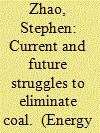

|
|
|
|
|
| Summary/Abstract |
Reductions in coal use necessary to meet the objective of keeping global temperature increase well under 2.0 °C faces serious political economic hurdles. To transition from coal, existing use must be eliminated and new growth in coal consumption must be stymied. Efforts to reduce existing consumption in a speedy manner faces challenges in domestically oriented markets where coal industry coalitions resist anti-coal policy and pursue industry protection. In addition, we identify a serious loophole in coal restraint exercised by a number of the users including: China, Japan and Korea. Continued support for coal capacity expansion abroad in both public and private sectors in these markets appears to reflect the lack of incentives, or sanctions in reining in such external capacity expansion. Such external expansion currently is not counted in nationally determined commitments for the Paris Agreement of the United Nations Framework Convention on Climate Change (Paris Agreement). Without greater national political efforts, the necessary reduction in coal use cannot be achieved.
|
|
|
|
|
|
|
|
|
|
|
|
|
|
|
|
|
|
|
|
|